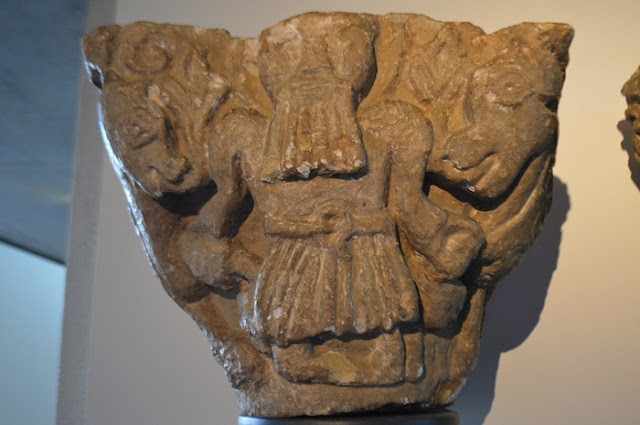Musee de l'Ancien Eveche | Two Capitals
I have long adored this pair of Romanesque
capitals and they form a personal highlight of every visit to this museum. They
are carved from a local sandstone known as molasse, and date to the 11th century. They come
from a church, now destroyed, in Bocsozel, a small town about 40km to the
north-west of Grenoble. As capitals, they would have sat on top of pilasters or
columns of some description within the church. The museum's information card doesn't comment as to whether or not there were further carved capitals in the
One capital is interpreted by the museum as Daniel in the Lion’s
Den. Daniel was a Hebrew during the period of the Babylonian Captivity and was
sentenced to Death by Lion (Pantheracide? … though that would be the other way
around …). Surprisingly, he didn’t get mauled and eaten and the miracle was
taken as a teachable moment about the tangible rewards of faith. As a child, I
was more taken by the detail of how those who conspired against Daniel were
themselves thrown to the lions, along with their wives and children. Obviously,
the way it was taught was to highlight the severe price of colluding against a
man of faith, but it struck me (even then) as rather sinister that a supposedly
merciful god would also require the murder of numerous small children to
appease his anger. Be that as it may, I’m unsure about these lions. I know that
there’s a long history in western art of depicting non-native animals poorly,
especially lions. But still … Daniel looks like he’s holding hands/paws with
the lions, not fervently praying that they don’t suddenly feel like a snack.
Instead I wonder if this isn’t actually an image of the coming of Christ as
prophesised by Habakkuk and given variously as: ‘In the midst of two animals
thou shalt be known’ or ‘between two beasts are you known’, itself a probable
inspiration for many’s a nativity scene.
The second capital shows the
Archangel Michael in the act of weighting souls at the Last Judgment. This act,
formally known as the psychostasia, is a fundamental tenet of Christian
mythology where the good are sent to Heaven and the damned go to Hell. The idea
appears in Classical mythology, for example in the Iliad, but is best known
from various Egyptian sources where the heart of the deceased is weighed by
Anubis and overseen by Toth. In Egyptian lore the heart (representing the
life-spirit ‘Ka’) is weighed against the feather of Ma’at. On the Bocsozel
capital Michael holds the scales to judge the two naked characters. Eagerly
awaiting the outcome of this process, a grimacing demon with a trident and an
accompanying serpent stands to St Michael’s left.
Readers familiar with Irish
archaeology will recall the similar scene on the east side of Muiredach's
Cross, from Monasterboice, County Louth. This example is about a century older
than Bocsozel and is conventionally dated to the period from 900 to 923 AD.
Other well-known examples of the psychostasia include one on the west tympanum
of Notre Dame Cathedral in Paris that is dated to the period from 1163 to 1250
AD. Together, these examples show the enduring power of this image of divine
retribution.
In considering the capitals as a
pair, my initial though was that 'Daniel in the Lion’s Den' was the correct
reading of the first example. In this way they would, perhaps on either side of
a chancel arch, convey a unified message about the fate that awaits the ungodly
and the unbeliever. That said, the idea of both capitals conveying a unified
message still holds good, even with the Habakkuk interpretation. Such a
scenario would see the two carvings speaking to the viewer about the End of
Days and the imminent return of the Messiah and the inevitable Judgment. No
matter how one chooses to interpret these pieces, I think that most can agree
that they’re not high art. Even for the 11th century, they’re not examples of
the very best of the stone carver’s art. So what’s the fascination? For me, at
least, it’s that although they lack something in ability, they
still have an arresting quality that draws the eye and excites the mind. The
other part is that, despite the shortcomings of the sculptor,* they are still
part of a larger set of illustrative and liturgical themes within western art – and beyond – that spans over several centuries. It’s a simple notion, but one
that I find endlessly fascinating – whether you were in Paris, Monasterboice,
rural France, or wherever, you could gaze up to contemplate the coming of the
Messiah and the Judgment.
Admittedly, it would have been at a smaller subset of these sites where you could have looked up and thought: ‘What are those animals
Admittedly, it would have been at a smaller subset of these sites where you could have looked up and thought: ‘What are those animals
Note
* I would just like to acknowledge
that, whatever the skills and limitations of the sculptor who produced these
capitals, their abilities surpasses my own in this regard.
 |
| Capital as photographed in 2003 |
 |
| Capital as photographed in 2003 |









Comments
Post a Comment